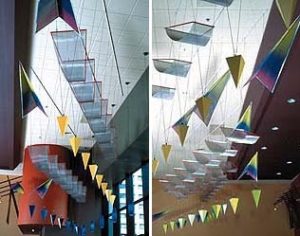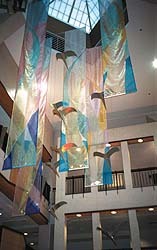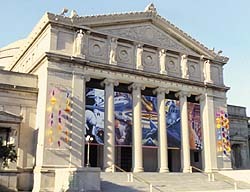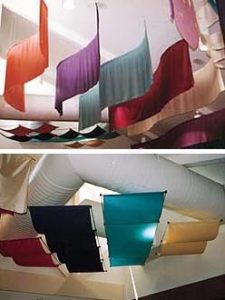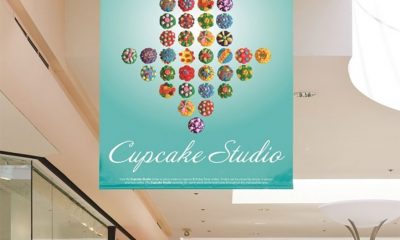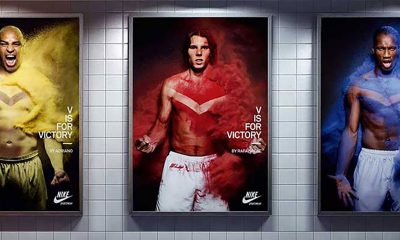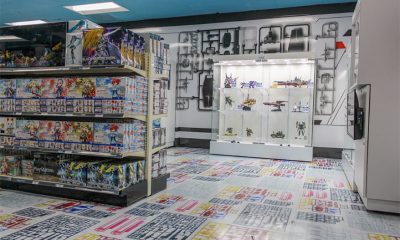Banners + Awnings
Banners Stretching the Imagination
Innovative uses of banner material
Published
18 years agoon
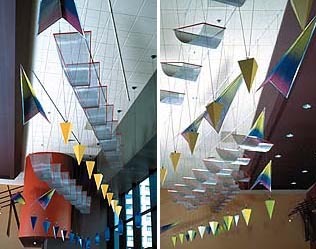
Mention the word "banner," and what kind of image comes to mind? Do you see a plastic-looking, flimsy material with red and blue Helvetica lettering, tied up with ropes and strings and folding over itself in the wind? Do you picture pole-mounted, decorative street signs announcing an upcoming event in a city? Or does the word "banner" open up a million different possibilities from visual merchandising to architectural enhancements?
If you’re like most people, you probably think a banner’s a banner’s a banner’s a … But wait! Have you noticed the banner revolution over the past five years? This flexible fabric is flourishing, and end users are finding innovative ways to incorporate this material into more than just traditional signage.
As a signshop, what does this mean to you? It means you can offer your customers a wide range of application possibilities. This is good news. With so many people getting into the sign business, diversifying your product offerings will help you stay competitive. Keep an open mind, be creative, and your clients will appreciate the benefits of your innovative ideas.
For example, if you already apply graphics to banner material and know how to install, why not use the same fabric as an architectural enhancement — either as part of a signage package or on its own? In fact, many sign companies that once fabricated only traditional banners are finding that the use of banner fabric is limited only by the imagination.
To help you expand your business, banner material manufacturers offer a plethora of materials in a wide range of fabrics. Not only are there numerous types of material, the products are more durable and versatile than ever before — and in more colors, too. Plus, the possibilities for fabric decoration are virtually limitless. Many materials receive one or a combination of screen printing, paint, vinyl, dye-sublimation, and, of course, digital imaging. The key, as with anything, is to speak to the manufacturers and then experiment on your own.
With this expanded material market may come confusion. As a signshop, how do you know what material to use for a particular non-signage application? In the Industrial Fabric Products Review’s September issue, an article entitled "Banners as Visual Merchandising Tools" reports that the message you convey can be influenced by the type of material you choose. For instance, fabric textures that are silky or satiny tend to suggest something more feminine or sensuous, while rougher fabrics, like canvas, coarse cottons or wool, are regarded as masculine or earthy. Color is another important consideration. According to the article, red, orange, yellow and brown typically convey warmth, while blues, greens and purples are cool, calming colors. And on a practical level, consider a fabric’s fire retardancy for indoor, public-space installations.
The article gives an overview of materials and how they can most appropriately be used. Here is a list of some fabrics designed for indoor use:
Lightweight nylon offers a smooth, satiny finish, especially when well-lit. It also drapes nicely and has a tight weave for exhibiting fine graphic detail.
Canvas, which is made from cotton weaves, has a natural, earthy look and is often used to convey a natural image. Canvas prints on one side only.
Satin has a smooth, glossy look because of the material’s weave. This material denotes elegance.
Organza is a sheer fabric that can present a striking, transparent, two-sided image. Because it is difficult to print on this material, permanent dyes are generally used to create a smooth, flowing drape for indoor applications only.
Bengaline is a rich, woven fabric with a ribbed finish that conveys a message of high quality.
Silk, although an expensive material and difficult to work with, gives a dramatic look to banner applications. It’s recommended that you conduct a test print on the product before attempting a final print and making a costly mistake. Images are printed on one side for indoor use only.
It’s a Bird, It’s a Plane, It’s . . . a Banner?
Designed as a public-art project, Seattle-based Koryn Rolstad Studios/ Bannerworks Inc. created the unique banners shown above for the Meridian 16 Cineplex Odeon Theatre in Seattle. Designed to help give scale to very high interior spaces, the project consists of "flying" metal pieces that hang from the theater’s ceiling. Throughout the first and third floors, giant plumb-bobs painted red, green or blue hang at the end of V-shaped, red cables. Midway on the cables, red metal frames with stainless-steel mesh draped inside form abstract clouds. And squadrons of 6-foot-long, airbrushed green, yellow, blue and magenta darts fabricated from stainless-steel mesh fly in and out of the clouds.
Koryn Rolstad Studios/Bannerworks designed and installed this project, and fabricated it with some help from other Seattle-based companies. Dill Works Inc. created the 6-foot-long darts, which actually look like paper airplanes. An aluminum flat bar and steel rods were used for their installation.
The plumb bob, or upside-down, hanging triangles, are sheet-metal shapes painted in blue, green and yellow, which are suspended by red-coated cable along with the cloud forms. Color Tech painted the triangles, and Rainier Industries fabricated them.
Additionally, the clouds — actually draped mesh — consist of a stainless-steel mesh in a steel square tube metal frame with the plumb bobs suspended below. Teeters cut the mesh; Rainier Industries created the frames and Color Tech painted them.
Banners that Soar
For the Meriter Hospital in Madison, WI, Koryn Rolstad Studios/Bannerworks Inc. created these high-flying banners. Designed to have a peaceful, calming effect on people in the hospital’s new Cardiac Care Center, Bannerworks employed long, narrow, sheer panels in layers to evoke the image of light rays mixed with rain. The banners are positioned to allow clear views of the architecture from many angles. To add to the environment’s ambiance, bird forms, fabricated of metal, acrylic and holographic film, soar through the space. The overall design compliments the architecture and accents the space’s natural light.
Koryn Rolstad Studios fabricated the banners out of sheer, appliqued materials in irridescent gold, purple, lilac, fuchsia, pink and peach. Sheer nylon sparkle material in pink, lilac, melon, dusty blue and magenta was also used.
|2414| (Seattle) routed the acrylic bird wings and applied a holographic film. The bird body is bent aluminum manufactured by Reliance (Bothell, WA). Koryn Rolstad Studios then joined together the metal body and wing forms.
Little Rock’s Arkansas Flag & Banner Inc. is proof positive that a little ingenuity and a lot of entrepreneurial spirit go a long way. This 23-year-old company, founded by Owner Kerry Thompson-McCoy, started out as a flag company. For the first nine years, Thompson-McCoy operated the business on a part-time basis, but she eventually plunged into the business full-time. And her risk paid off. Today, the company makes custom flags and banners of all kinds using everything from applique and screen printing to large-format digital imaging.
These banners, located at Chicago’s Museum of Science and Industry, represent the first time the museum had worked on a project with Fabric Artworks Intl., Arkansas Flag & Banner’s sister company. But Laima Day, senior designer/marketing for the museum, trusted Fabric Artworks to make the right choices.
Designed for the Museum’s four-day "What’s New Debut," which celebrated a new parking garage, truly dynamic exhibits and a visit planning center, the banners featured related icons. Local Artist Thomas Melvin created the artwork by first hand-painting collages of icons — such as trains, planes, ferries and outer space — on canvases measuring approximately a third of the final print’s size. Melvin’s scaled-down paintings were then photographed, and the transparencies were scanned in and enlarged to create 9 1/2-by-24 1/2-foot-tall images.
Kathleen Nowell King, sales manager at Fabric Artworks, coordinated the banner fabrication. The company employed the Nur America Inc. (Moonachie, NJ) Blueboard piezo-electric printer because of its rich color saturation, and chose Ultraflex Systems Inc.’s (Randolph, NJ) UltraMesh 500 banner material as the substrate. According to King, the mesh is a strong, high-quality material with enough surface to render a rich-looking image, but with a loose-enough weave to let the air through — an important factor considering Chicago’s infamous strong winds. Additionally, the material’s 16-foot width allowed printing without seams. Once printed, Chicago-based Sterling Sails installed the banners using a pulley system with reinforced webbing.
Although the actual banner creation was not incredibly difficult, coordinating the project was. King says because the museum is a historical building, the biggest obstacle was getting approval from the Landmark Committee. She says, "Everything was a big deal." But once the banners were installed, King says the museum was absolutely thrilled.
One Cool Banner Project
Denver-based Colorburst Signs & Graphics is no stranger to innovative banner jobs. President and Founder Wade Rawls started the company in 1982 as an awning-maker. Although the business gradually evolved into a full-service sign company, Rawls’ first love is fabric. He talks excitedly and knowledgeably about the range of fabric applications, available colors and materials. Then he simply adds, "Fabric is cool."
Colorburst designed, fabricated and installed these decorative banners for the Thorton Recreation Center in Denver. The $10,000 project camouflages duct work on the ceiling and serves as an enhancement to an otherwise sterile environment. The banners, which are nylon 210 denier (Glaser Mills, Great Neck, NY), consist of two parts: a series of curved, vertical, hanging banners (pictured here) and an artsy central piece comprised of abstract, dangled objects with metal rods that hold the shapes (not pictured).
Rawls estimates the company used approximately 180 feet of material for the whole project and adds that the nylon denier was chosen for its translucence, range of available colors and ease of movement (with help from the air-conditioning ducts). After pitching a few different design ideas for the project, the client chose one, and Colorburst fabricated and installed the project in eight days. To hang the banners in an inconspicuous fashion, ceiling ties were first bolted into the ceiling, and the banners hang from thin wires.
The project was a great success for the client and has led to similar jobs with other recreation centers. Rawls says this project has inadvertently made his company a "recreation-center expert," a role he is happy to fill.
Banners too Sexy for Milan
In our complex, fast-paced world, getting a simple message across is, well, not so simple anymore. To be noticed, advertisements must be eye-catching, shocking or just plain big. And if you combine all three, the results can be dramatic. Fortunately for advertisers, the availability of large-format digital printing, durable materials and a wealth of creativity combine often to produce advertisements that pack a punch.
Take this project created by Amersterdam-based Souverein Projects B.V., a company that offers digital-printing services to some of the most prestigious advertising agencies, designers and photographers in Europe. According to Managing Director Hans van Dijk, the company has to translate a constant stream of new and wild ideas into a "visual reality." Using the NUR Outboard and two NUR Blueboard large-format digital printers, Souverein can make just about any size banner. These 20-by-20-meter banners, printed for L’Oreal, cover scaffolding in Milan’s city center. The graphics were printed on a frontlit PVC material, and six separate tiles were pieced together for each banner. As such, accurate color matching and perfect tiling were a must.Commercial Plastics

SPONSORED VIDEO
Introducing the Sign Industry Podcast
The Sign Industry Podcast is a platform for every sign person out there — from the old-timers who bent neon and hand-lettered boats to those venturing into new technologies — we want to get their stories out for everyone to hear. Come join us and listen to stories, learn tricks or techniques, and get insights of what’s to come. We are the world’s second oldest profession. The folks who started the world’s oldest profession needed a sign.
You may like

6 Sports Venue Signs Deserving a Standing Ovation

Hiring Practices and Roles for Women in Sign Companies

Avery Dennison Adopts Mimaki Printer for Traffic Sign Print System
Subscribe

Bulletins
Get the most important news and business ideas from Signs of the Times magazine's news bulletin.
Most Popular
-

 Tip Sheet3 days ago
Tip Sheet3 days agoAlways Brand Yourself and Wear Fewer Hats — Two of April’s Sign Tips
-

 Business Management1 week ago
Business Management1 week agoWhen Should Sign Companies Hire Salespeople or Fire Customers?
-

 Women in Signs2 weeks ago
Women in Signs2 weeks ago2024 Women in Signs Award Winners Excel in Diverse Roles
-

 Real Deal4 days ago
Real Deal4 days agoA Woman Sign Company Owner Confronts a Sexist Wholesaler
-

 Editor's Note1 week ago
Editor's Note1 week agoWhy We Still Need the Women in Signs Award
-

 Line Time2 weeks ago
Line Time2 weeks agoOne Less Thing to Do for Sign Customers
-

 Product Buying + Technology1 week ago
Product Buying + Technology1 week agoADA Signs and More Uses for Engraving Machines
-

 Women in Signs4 days ago
Women in Signs4 days ago2024 Women in Signs: Megan Bradley
